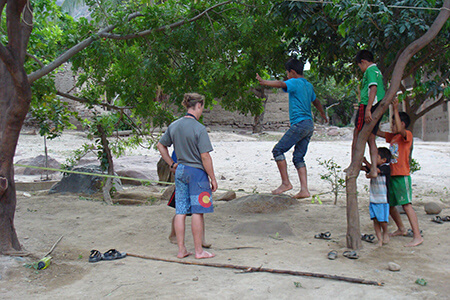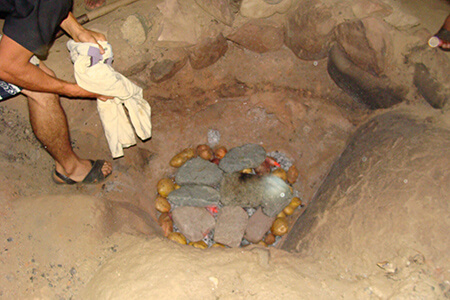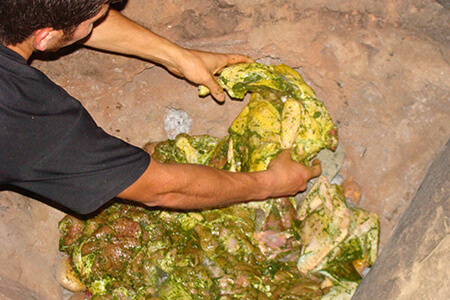We hiked from our camp on the beach back to the village at Tupén Grande for the evening festivities, which were to include the cooking of a traditional pachamanca. When we arrived, the town square was alive with villagers, done with their day of work and ready to enjoy the relative coolness of the evening. The evening was a celebration of sorts for the villagers because family members who went to school or worked in Lima or other cities were home for the Christmas and New Year’s holiday. An adult volleyball game and a soccer game were in full swing. The younger kids were still playing with the slack line and some were sledding down a dirt pile on a plastic oil container. They reminded me of kids sliding down a snow-covered hill at home—ah, the creativity of children.
When the games ended, a group of men gathered in front to the store to tell stories and drink sugar cane whiskey, while others chatted in small groups around the square. As darkness fell, we began to wonder about the cooking event of the evening—the pachamanca. Pedro said he had been told that the process would start soon, but it was already almost dark and the fire hadn’t even been started yet. He shrugged his shoulders in exasperation; he had done all he could do.



After it was full dark, a group of men finally started the fire in an earthen pit about three feet deep and three feet across at one end of the square. The man in charge had come home for the holiday from Lima, where he was the chef in his own restaurant. We learned that making a pachamanca was becoming a lost tradition, and many in the village didn’t know how to do it. So Rocky, at SierraRios, was encouraging the villagers to re-learn this tradition and giving them a way to earn money with that knowledge by preparing a pachamanca for tourist visitors like our group.
Soon a large fire was roaring in the pit. It was a warm evening, so people kept well back from the heat from the flames. More wood was added and burned down until the fire was reduced to a large bed of glowing coals. Then many flat rocks that had been soaked in water were added to heat in the coals. When the rocks were hot enough, the building of the Pachamanca began, and we and the villagers gathered round to watch.
First, our chef shoveled most of the hot rocks out of the pit, leaving a fairly thin layer in the bottom of the pit on top of the coals. Then he began to add potatoes and sweet potatoes, which the women had brought in big round tubs. He made a circle of potatoes around the perimeter of the pit on top of the hot rocks and placed more hot rocks to fill in the circle and cover the potatoes. Then he added chicken and pork, which he had prepared earlier and marinated in spices. The meat sizzled as he laid it out flat over the hot rocks. Then more villagers came with banana leaves, which the chef laid over the top of the meat layer, completely sealing the food into the pit. More hot rocks were laid over the banana leaves. To ensure a tight seal, the chef laid plastic gunny sacks on next and several men began shoveling dirt onto the gunny sacks. The gunny sacks, the one concession to modern materials, would make it easier and cleaner to remove the dirt once the cooking was done. Our chef stomped the dirt thoroughly and tightly over the surface of the pit, blocking every potential air hole and sealing the pit carefully and completely.





The pachamanca would take about an hour and a half to cook. By this time it was nearly 9:00 pm, and we were getting tired after our long day of rapid running and playing with the villagers. It was going to be a very late meal, and some of our group gave up and went back to camp to go to bed. A few of us stayed and napped on the dirt ledges around the perimeter of the square. At 10:30 pm, the chef and his helpers removed the gunny sacks and their load of dirt, peeled back the banana leaves and removed the rocks and the steaming food. As the paying guests, our group was fed first, and wow! What a wonderful meal; not just because it was late and we were all very hungry, but because it was perfectly cooked. We were truly impressed. The spices from the meat had infused the vegetables with flavor, and the meat itself was tender and delicious. Our hosts seemed pleased, and I was anxious to see them dig into the food, too. We thanked them profusely for their work and expertise and for sharing this special tradition with us, and once we had finished eating, we said our goodnights, so that they could continue their party and enjoy their meal, too. We hiked back to camp in the dark, and fell gratefully into our beds. What an experience, and what a very long day. Tomorrow we would float on downstream. I drifted off feeling deeply satisfied and grateful for such a positive experience with the amazing people of Tupén Grande.
Read more entries in our ten-part series about the Rio Marañon.
To raft and/or help protect the Rio Marañon, contact SierraRios at www.sierrarios.org











